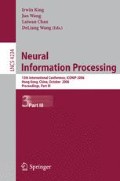Abstract
This paper studies pulse-coupled network of digital spiking neurons and its basic dynamics. The neuron is constructed by coupling two shift registers and has a variety of spike-trains which correspond to digital codes through a inter-spike interval (ISI) modulation. The pulse-coupled network has master-slave configuration. All the spike-trains of neurons in the master side are multiplexed additionally and are transmitted to the slave side via single line. Neurons in the slave side are connected by dynamic winner-take-all function. As parameters are selected suitably, the slave can realize demultiplexing and master-slave synchronization is achieved. VHDL simulation is also discussed for FPGA implementation and this digital network is compared with an analog network.
Access this chapter
Tax calculation will be finalised at checkout
Purchases are for personal use only
Preview
Unable to display preview. Download preview PDF.
References
Torikai, H., Hamanaka, H., Saito, T.: Novel digital spiking neuron and its pulse-coupled network: spike position coding and multiplex communication. In: Proc. IJCNN, pp. 3249–3254 (2005)
Glass, L., Mackey, M.C.: A simple model for phase locking of biological oscillators. J. Math. Biology 7, 339–352 (1979)
Perez, R., Glass, L.: Bistability, period doubling bifurcations and chaos in a periodically forced oscillator. Phys. Lett. 9, 441–443 (1982)
Lee, G., Farhat, N.H.: The bifurcating neuron network 1. Neural networks 14, 115–131 (2001)
Torikai, H., Saito, T., Schwarz, W.: Synchronization via multiplex pulse-train. IEEE Trans. Circuits Syst. I 46(9), 1072–1085 (1999)
Torikai, H., Saito, T.: Synchronization phenomena in pulse-coupled networks driven by spike-train inputs. IEEE Trans. Neural Networks 15(2), 337–347 (2004)
Kon’no, Y., Saito, T., Torikai, H.: Rich dynamics of pulse-coupled spiking neurons with a triangular base signal. Neural Networks 18, 523–531 (2005)
Kim, S.C., Lee, B.G.: A theory on sequence spaces and shift register generators. IEEE Trans. Comm. 44(5), 609–618 (1996)
Guan, S., Zhang, S.: An evolutionary approach to the design of controllable cellular automata structure for random number generation. IEEE Trans. Evolutionary Computation 7(1), 23–26 (2003)
Hopfield, J.J., Herz, A.V.M.: Rapid local synchronization of action potentials: Toward computation with coupled integrate-and-fire neurons. Proc. Natl. Acad. Sci. 92(15), 6655–6662 (1995)
Campbell, S.R., Wang, D., Jayaprakash, C.: Synchrony and desynchrony in integrate-and-fire oscillators. Neural Comput. 11, 1595–1619 (1999)
Nakano, H., Saito, T.: Grouping synchronization in a pulse-coupled network of chaotic spiking oscillators. IEEE Trans 15(5), 1018–1026 (2004)
Izhikevich, E.M.: Weakly pulse-coupled oscillators, FM interactions, synchronization, and oscillatory associative memory. IEEE Trans. Neural Networks 10(3), 508–526 (1999)
Maggio, G.M., Rulkov, N., Reggiani, L.: Pseudo-chaotic time hopping for UWB impulse radio. IEEE Trans. Circuits Syst. I 48(12), 1424–1435 (2001)
Torikai, H., Hamanaka, H., Saito, T.: Reconfigurable Digital Spiking Neuron and its Pulse-Coupled Network: Basic Characteristics and Potential Applications. IEEE Trans. Circuits Syst. II (2006)
Author information
Authors and Affiliations
Editor information
Editors and Affiliations
Rights and permissions
Copyright information
© 2006 Springer-Verlag Berlin Heidelberg
About this paper
Cite this paper
Kabe, T., Torikai, H., Saito, T. (2006). Synchronization Via Multiplex Spike-Trains in Digital Pulse Coupled Networks. In: King, I., Wang, J., Chan, LW., Wang, D. (eds) Neural Information Processing. ICONIP 2006. Lecture Notes in Computer Science, vol 4234. Springer, Berlin, Heidelberg. https://doi.org/10.1007/11893295_126
Download citation
DOI: https://doi.org/10.1007/11893295_126
Publisher Name: Springer, Berlin, Heidelberg
Print ISBN: 978-3-540-46484-6
Online ISBN: 978-3-540-46485-3
eBook Packages: Computer ScienceComputer Science (R0)

